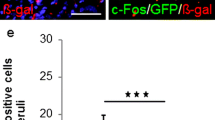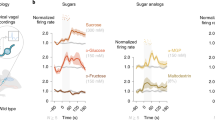Abstract
The complex physiology of the gastrointestinal (GI) tract must permanently be adjusted according to the composition of ingested food, which requires continuous monitoring by appropriate sensory systems. Sensing the dietary constituents is thought to be mediated by chemosensory cells residing in the mucosa of the GI tract. We have examined the appearance and differentiation of candidate chemosensory cells at distinct postnatal stages and visualized cells that express gustducin or TRPM5. Two critical stages have been considered: the suckling period when the neonates are nourished exclusively on milk and the weaning period when the diet gradually changes to solid food. At early postnatal stages, only a few gustducin- or TRPM5-expressing cells have been found; they display an immature morphology. At the time of weaning, numerous gustducin- or TRPM5-positive cells are present in the gastric mucosa and are isomorphic to adult candidate chemosensory cells. The typical accumulation of gustducin and TRPM5 cells at the border between the forestomach and corpus region and the characteristic tissue fold or “limiting ridge” have not been observed at early postnatal stages but are complete at the time of weaning. The appearance of candidate chemosensory cells at the strategic position occurs within the last few days before weaning but after the formation of the limiting ridge. Thus, both the topographic arrangement of the cells and the limiting ridge seem to be important features for the processing of solid food in the mouse stomach.







Similar content being viewed by others
Abbreviations
- CV:
-
circumvallate papillae
- GI:
-
gastrointestinal
- LR:
-
limiting ridge
References
Bezençon C, Coutre J le, Damak S (2007) Taste-signaling proteins are coexpressed in solitary intestinal epithelial cells. Chem Senses 32:41–49
Clapp TR, Stone LM, Margolskee RF, Kinnamon SC (2001) Immunocytochemical evidence for co-expression of Type III IP3 receptor with signaling components of bitter taste transduction. BMC Neurosci 2:6
Clark SL (1959) The ingestion of proteins and colloidal materials by columnar absorptive cells of the small intestine in suckling rats and mice. J Biophys Biochem Cytosol 5:41–51
Hass N, Schwarzenbacher K, Breer H (2007) A cluster of gustducin-expressing cells in the mouse stomach associated with two distinct populations of enteroendocrine cells. Histochem Cell Biol 128:457–471
Hass N, Schwarzenbacher K, Breer H (2010) T1R3 is expressed in brush cells and ghrelin-producing cells of murine stomach. Cell Tissue Res 339:493–504
Henning SJ (1981) Postnatal development: coordination of feeding, digestion, and metabolism. Am J Physiol 241:G199–G214
Hill KJ (1956) Gastric development and antibody transference in the lamb, with some observations on the rat and guinea pig. Q J Exp Physiol 41:421–432
Höfer D, Püschel B, Drenckhahn D (1996) Taste receptor-like cells in the rat gut identified by expression of alpha-gustducin. Proc Natl Acad Sci USA 93:6631–6634
Kaske S, Krasteva G, König P, Kummer W, Hofmann T, Gudermann T, Chubanov V (2007) TRPM5, a taste-signaling transient receptor potential ion-channel, is a ubiquitous signaling component in chemosensory cells. BMC Neurosci 8:49
Luciano L, Reale E (1992) The “limiting ridge” of the rat stomach. Arch Histol Cytol 55 (Suppl):131–138
Manville IA, Lloyd RW (1932) The hydrogen ion concentration of the gastric juice of foetal and new-born rats. Am J Physiol 100:394–401
Nelson G, Hoon MA, Chandrashekar J, Zhang Y, Ryba NJ, Zuker CS (2001) Mammalian sweet taste receptors. Cell 106:381–90
Nelson G, Chandrashekar J, Hoon MA, Feng L, Zhao G, Ryba NJ, Zuker CS (2002) An amino-acid taste receptor. Nature 416:199–202
Robert A (1971) Proposed terminology for the anatomy of the rat stomach. Gastroenterology 60:344–345
Rozengurt N, Wu SV, Chen MC, Huang C, Sternini C, Rozengurt E (2006) Colocalization of the alpha-subunit of gustducin with PYY and GLP-1 in L cells of human colon. Am J Physiol Gastrointest Liver Physiol 291:G792–G802
Sutherland K, Young RL, Cooper NJ, Horowitz M, Blackshaw LA (2007) Phenotypic characterization of taste cells of the mouse small intestine. Am J Physiol Gastrointest Liver Physiol 292:G1420–G1428
Wattel W, Geuze JJ (1978) The cells of the rat gastric groove and cardia. An ultrastructural and carbohydrate histochemical study, with special reference to the fibrillovesicular cells. Cell Tissue Res 186:375–391
Acknowledgments
We kindly thank Prof. Gudermann and Dr. Chubanov for providing us with the anti-TRPM5 antibody for our analyses.
Author information
Authors and Affiliations
Corresponding author
Additional information
This work was supported by the Deutsche Forschungsgemeinschaft (BR 712/25-1). Nicole Hass is a recipient of a Peter und Traudl Engelhorn Stiftung scholarship.
Rights and permissions
About this article
Cite this article
Sothilingam, V., Hass, N. & Breer, H. Candidate chemosensory cells in the stomach mucosa of young postnatal mice during the phases of dietary changes. Cell Tissue Res 344, 239–249 (2011). https://doi.org/10.1007/s00441-011-1137-2
Received:
Accepted:
Published:
Issue Date:
DOI: https://doi.org/10.1007/s00441-011-1137-2




